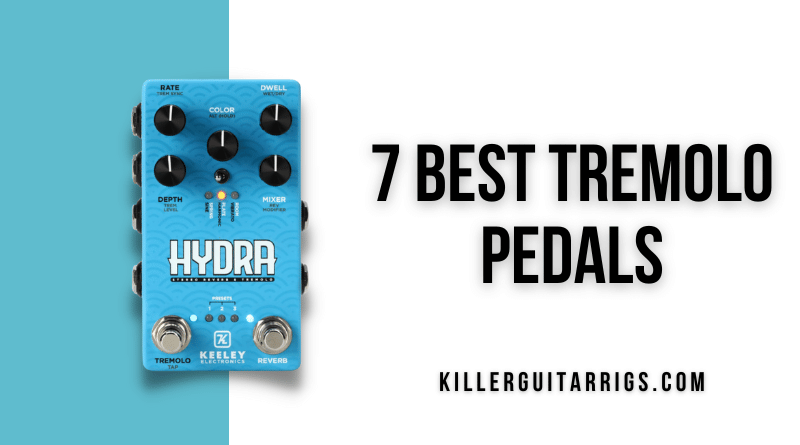A good tremolo pedal can be a tremendous asset in your pedal board. It can add personality and depth to your tone or take you on a journey of lush experimentation.
However, as useful as it is, tremolo is also the most underrated tool among modulation effects. The good news is that in recent years, tremolo pedals have become popular, and there are endless options out there.
The tremolo effect itself is not new by any means. It has been a staple guitar playing for the last eight decades. It was common to find a tremolo knob on Fender amps since the early ‘50s, although it was then labeled as “vibrato.”
Whether you’re looking for a modern tremolo pedal, a vintage amp-like harmonic tremolo, or you’re just a beginner shopping for a basic model, we’ve got you covered.
Below we have seven great choices that go from basic to advanced and detailed, as well as anything in between. Keep Reading.
Read more about our review process.
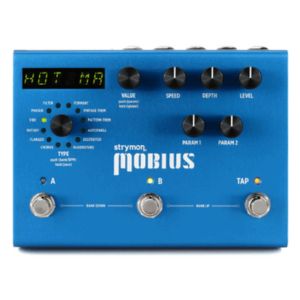
Strymon Mobius Multidimensional Modulation Pedal
Features: 12 Modulation types, MIDI controllable, 200 Customizable presets
Benefits: Studio quality sound, Highly customizable tones, User friendly operation
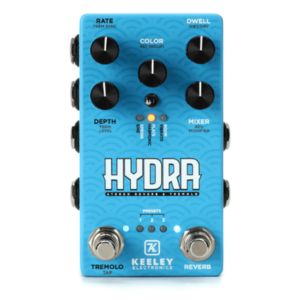
Keeley Hydra Stereo Reverb & Tremolo Pedal
Features: 3 Tremolo types, All metal construction, Stereo compatible
Benefits: Easy to recall presets, Simple interface, Low noise performance
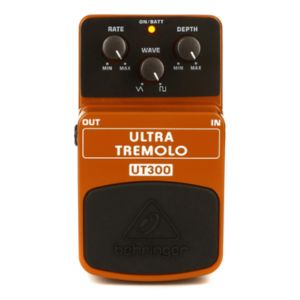
Behringer UT300 Ultra Tremolo Pedal
Features: Rate and depth controls, 9v Battery or DC power, Electronic on/off switch
Benefits: Superb vintage tremolo effects, Adjustable tremolo character, Extremely affordable
Contents
Our Top 3
The Keeley Hydra Stereo Reverb and Tremolo is our Top Pick. It features three tremolo types, as well as three stereos and reverbs for a great variety of tones with depth. Besides great tone and build, it also comes with instant save and recall for custom tones.
The Behringer Ultra Tremolo UT300 is our Budget Choice. This pedal is a vintage-style tremolo designed to replicate the warmth and natural harmonics of tube amps from the ’50s and ’60s, giving you a fantastic choice at a very affordable price.
Finally, the Strymon Mobius Multidimensional Modulation is our Editor’s choice. This pedal is for the consummate professional and features 12 modulation effects types and top-notch audio quality for a remarkable tonal pallet for modulation effects.
Individual Reviews

Keeley Hydra Stereo Reverb & Tremolo
A complete yet simple unit that is quite versatile.
Keeley is one of the most respected pedal brands among well-informed guitarists, as they excel in quality and functionality. The Hydra is no exception as it offers great features, tone, and versatility.
The Keeley Hydra Stereo Reverb and Tremolo feature three tremolo types, and three stereo reverbs so that you can dial in a broad variety of tones with depth. This pedal also comes with three user preset slots, where you can save and recall your own custom tones instantly.
With a fantastic design by Robert Keeley, the Hydra is a great choice for guitarists who need to recall several reverb and tremolo settings live and in the studio.
The Keeley Hydra comes with vintage-voiced tremolo effects. You get to choose from Vibrato, Harmonic, and Sine wave tremolo types and rely on the tap tempo function to dial it in exactly as you want it.
On the other hand, for the reverb section, you get to choose between the Room, Plate, and Spring types. The Hydra allows you to change the order of the effects on the fly with the touch of a button. If you need even more control options, the Hydra features a TRS expression pedal input.
We tried this pedal with our Strat plugged into our Twin Reverb amp. In our tests, we loved how the Hydra is designed in a way that allows for intuitive operation. On the pedal’s left, you get the Tremolo switch that also doubles as the tap tempo button. On the right, you get the switch for activating your reverb.
The Hydra gave us everything from straightforward to rich tremolo, and we loved the three different reverbs as they are a nice complement to this pedal. The Wet/Dry knob at the top right-hand corner of the pedal was particularly useful as we could dial in the right amount of tremolo, making this pedal very flexible and versatile.
In short, another fantastic unit from Keeley, with great sound, plenty of tone-shaping options, and built like a tank.
Verdict: The Keeley Hydra Stereo Reverb and Tremolo is a versatile and very useful pedal that features three tremolo types as well as three stereo reverbs. Well-built and well-designed, this pedal gives you save and recall options so you can build your own custom tones.
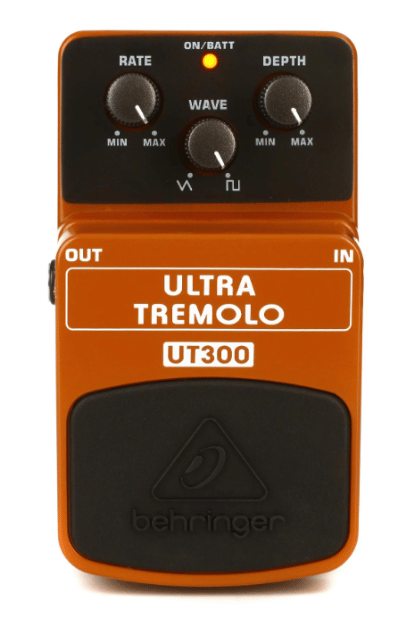
Behringer UT300 Ultra Tremolo Pedal
A fantastic option for beginners looking for value.
Behringer is known for providing affordable solutions for musicians for decades. The UT300 is further proof of this and offers a good deal of quality and functionality for the money.
The Behringer Ultra Tremolo UT300 is a vintage-style tremolo designed to reproduce the warmth and natural harmonics element of tube amps from the ’50s and ’60s. This pedal also gives you good control over your tone by providing separate knobs for range and depth.
Another nice feature on the UT300 is the Wave control knob, which allows you to select between a softer triangle waveform or a harder square. This control lets you get closer to emulating a transistor-type tremolo or an optical one.
For our tests, we used our Fender Strat and Twin Reverb amp. For a pedal this cheap, we really liked it performed. We got good tremolo that could go from subtle to pronounced, and we were able to change the waveform on a whim. We particularly like our tone with the Depth knob at 11 o’clock, Rate at 10 o’clock, and the Wave knob right at 12 o’clock for a subtle but effective tremolo.
This pedal comes in your typical Behringer stompbox enclosure and design and works with a standard 9 V battery, or you can run it via an optional power supply.
In short, a great tremolo pedal for beginners at a truly affordable price.
Verdict: The Behringer Ultra Tremolo UT300 is a vintage-style tremolo developed to replicate the warmth and natural harmonics of tube amps from the ’50s and ’60s. Truly affordable and ideal for beginners, this pedal offers good tonal control via three knobs labeled Range and Depth and Wave.
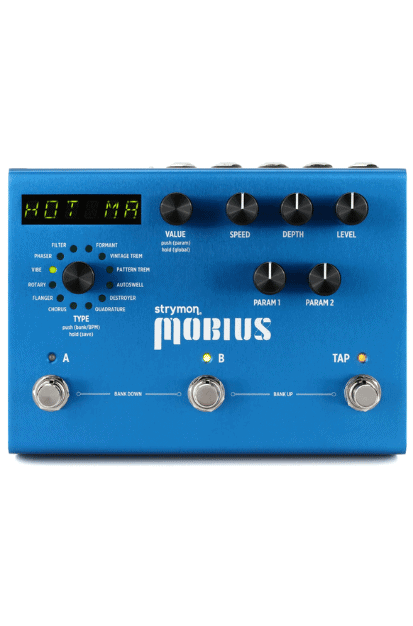
Strymon Mobius Multidimensional Modulation Pedal
A modulation machine for dedicated professionals.
Strymon has risen to the top of the effect pedal pantheon as they provide superb quality and quality solutions for professional musicians. The Mobius is another example of the depth and quality that this company offers with each pedal it produces.
The Strymon Mobius Multidimensional Modulation Pedal features 12 modulation effects types and is powered by a strong SHARC DSP that ensures top-notch audio quality. It comes with an impressive 200 customizable presets, is MIDI controllable, and also features an expression pedal input.
The Type knob is where you select one of the 12 modulation effects on this unit. It is a hybrid rotary/push-button control that lets you choose between chorus, flanger, rotary, vibe, phaser, filter, formant, vintage trem, pattern trem, auto swell, destroyer, and quadrature. Naturally, all these choices amount to a truly impressive tonal pallet for modulation effects.
Your chosen modulation type is then displayed on the LED, which also shows you the modulation rate in beats per minute.
The level, depth, and speed knobs are in the upper right section. It is important to note that the function of the Depth control can vary depending on the selected modulation Type that is chosen at any given moment.
Right below, we find the Param 1 and 2 knobs, which control the assignable parameters for each modulation type. These two knobs give you great control over each of the modulation types, and can give you stark variations on each.
For our tests, we went straight to the Rotary type. This modulation Type on the Mobius does an amazing job of emulating the natural sound of a mechanically rotated speaker array.
In this setting, the assignable parameters included horn level, preamp drive (simulating the tube preamp overdrive from a cranked Leslie), and an acceleration parameter. We got fantastic performance flexibility and an authentic rotary speaker tone.
We also loved the vintage tremolo and pattern trem types, as well as the seemingly endless flexible parameter options that this unit offers. In short, this is an impressive modulation pedal that gives you superior tone and extensive tonal manipulation.
Verdict: The Strymon Mobius Multidimensional Modulation Pedal gives you 12 modulation effects types with deep editing capabilities and great audio quality. With 200 customizable presets, the ability to be controlled by MIDI, and an expression pedal input, this pedal is for dedicated professionals who demand the best.
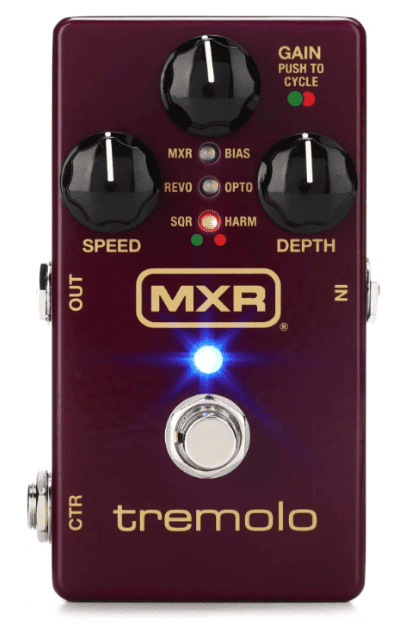
MXR M305 Tremolo
Simple and effective quality tremolo tones.
This MXR pedal excels in simplicity and delivers a straightforward solution for your tremolo needs. It comes with an intuitive yet highly functional design, as well as the durability that this company is known for.
The MXR M305 Tremolo Effects Pedal features six distinct tremolo modes as well as waveshapes modes based on vintage tremolo circuits. This unit also features a control out jack that can be used for expression control, envelope control, stereo audio output, or tap tempo.
The M305 comes in a simple 3-knob design. You get a Speed, Gain, and Depth knob. While all three are self-explanatory, the Gain knob has a dual function. You can select the six available modes by just pressing on this knob.
The first tremolo mode is labeled MXR, and it re-creates the rich pulsations of the MXR M159 Stereo Tremolo pedal. We then have Bias based on the power-soaked compression from ’60s tube amplifiers that featured built-in tremolo circuits.
Next up, you’ve got Revo, which gives you an optical tremolo waveform with exaggerated peaks and dips. This was our favorite in our tests, as it gave us a unique tremolo that was great for creating textures in an experimental context.
Following, there’s Opto, inspired by photocell tremolo circuits encountered in vintage amps, featuring a lush and smooth character. We really like this one as well, as it sounded gorgeous with open string chords, perfect for sparse rhythmic parts.
For choppy, pronounced tremolo, there’s SQR, a square-wave tremolo. Finally, there’s Harm, for experimental phase-like modulation, inspired by the harmonic tremolo found in vintage amps.
Despite offering a healthy variety of tremolo effects, this pedal features a small footprint. It is well built with a Rugged metal chassis as well as surface-mounted pots that ensure durability.
In short, a good tremolo pedal can be great in a variety of situations. Although it does sound good and is well-built, it does not offer deep editing abilities.
Verdict: The MXR M305 Tremolo offers six distinct tremolo modes as well as waveshapes modes inspired by vintage tremolo circuits. This unit is simple and intuitive to use, well built, and gives you great functionality as well as durability.
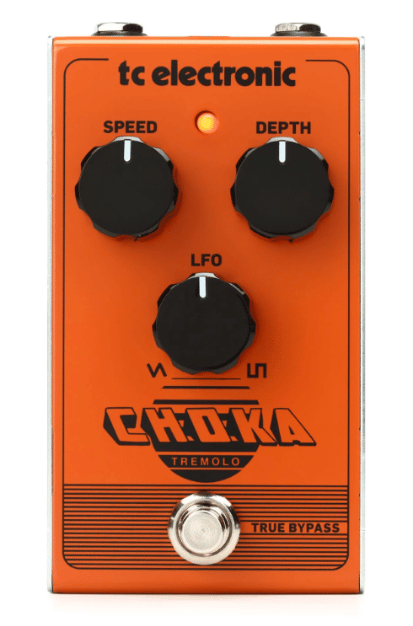
TC Electronic Choka Tremolo
Durability and simplicity at its finest.
This pedal has a minimalistic design that provides a great Tremolo that can go from subtle to aggressive. It is quite durable and a great choice for dialing in your tone quickly and effectively.
The TC Electronic Choka Tremolo Pedal offers classic amp tremolo tones in a simple and well-built all-analog design. This unit features true bypass circuitry as well as a straightforward 3-knob configuration with controls for speed, depth, and LFO.
We tested this pedal with our Gibson Les Paul plugged into our Fender Blues Jr. amp. We immediately liked how sturdy the chassis on this pedal felt and how bare-bones and to the point its design is. With just three knobs, one input, and one output, there is no confusion as to what this pedal offers.
We liked what this pedal gave us and how easy it was to dial in the sound we were after. For mild swells, we set the Speed and Depth at around 9 o’clock, with the LFO knob at 12 o clock. For more aggressive tremolo and hard chops that could veer us into experimental territory, we took the LFO knob all the way to 3 o clock, with the Speed at 12 o’clock and the Depth at 2 o’clock.
This pedal is built road-tough, with a metal housing that can take a beating and still survive for years. The Choka functions via a 9 V DC power supply that you can purchase separately.
In short, an easy-to-use pedal that allows you to dial your tone in no time. The Choka is built like a tank and is a great choice for folks who value simplicity and functionality. Guitarists who like to have greater control over their parameters may want to consider another option.
Verdict: The TC Electronic Choka Tremolo Pedal features classic amp tremolo tones in a minimalistic and durable analog design. With true bypass circuitry and a 3-knob configuration, you get a simple yet effective pedal that delivers all your basic tremolo effect needs.
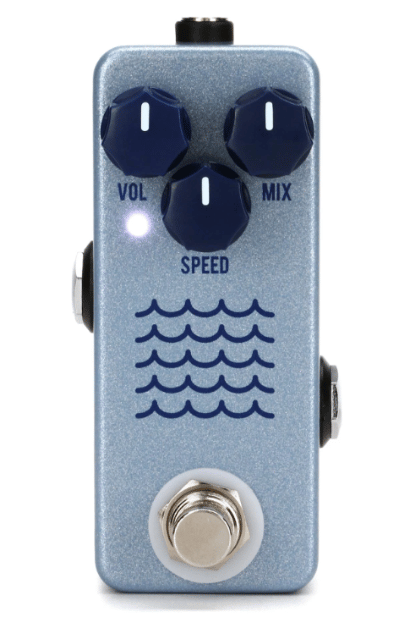
JHS Tidewater Mini Tremolo
A mini pedal that gets the job done.
If your pedalboard's space is severely limited but you still want to get a good tremolo pedal, then Tidewater is a terrific choice. It offers quality tone, simplicity, and functionality to handle your basic tremolo needs.
The JHS Tidewater Mini Tremolo was designed with the sound of the tremolo found on vintage Fender and Vox amps. It features a streamlined 3-knob design and internal DIP switches that allow you to pick a faster or slower speed range.
The Tidewater’s three control knobs are Volume, Mix, and Speed. The Volume lets you set the general volume at unity, below unity, or beyond unity for a boosted tone. The Mix knob controls the depth of the tremolo, where it can take you from subtle to wild.
Besides tremolo, you can also choose to use the Tidewater as a warm preamp boost by turning the Mix knob all the way down. Last but not least, the Speed knob lets you control how fast the tremolo is. This is also indicated by the LED to the left of the Speed knob.
Although it comes in diminutive and very convenient size, this pedal features three small dip switches on the back for further tonal control. You can dial in a faster range of speed by placing all three switches in the down position. On the contrary, place all three switches in the up position for a slower range of speed.
We tried this pedal with our Strat into a Twin Reverb and got nice results. The Tidewater operation is straightforward and gave us everything from gentle tremolo to a fully wobbly tone and anything in between.
This unit operates on a 9V DC power supply that is sold separately. In short, a convenient pedal that delivers the basic Tremolo in a simple and effective way. This pedal is especially good for beginners or those who have cramped pedalboards. As good as this pedal is, if you need more control options and parameter editing, you want to look elsewhere.
Verdict: The JHS Tidewater Mini Tremolo was designed with the sound of the tremolo found on vintage Fender and Vox amps. It features a streamlined 3-knob design and internal DIP switches that allow you to pick a faster or slower speed range.
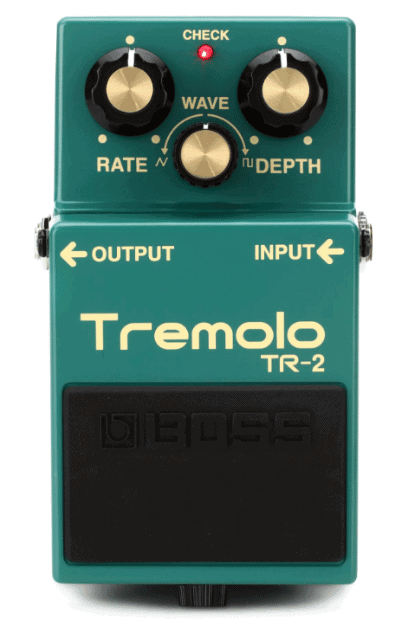
Boss TR-2 Tremolo
Durable and uncomplicated.
Boss needs no presentation in the guitar world. This company has dominated the stompbox market for decades and for good reason. The TR-2 brings the Boss ethos of simplicity and functionality to an easy-to-use tremolo pedal.
The Boss TR-2 Tremolo Pedal features an uncomplicated design and comes in a typical Boss stompbox format, with a tank-like chassis and a durable and dependable construction. With just one input and one output, this pedal comes with three control knobs to give you basic control over your tremolo.
To start off, the Rate control lets you dial in the tremolo speed, while the Depth knob defines how strong the effect is. You also get a Wave control to change the LFO waveform from triangle to square so you can get a bit more flexibility on your effect.
We tried this pedal with our Gibson Les Paul into a Fender Blues Jr. It gave us nice tonal quality and good range for such a barebones pedal.
The tremolo that the TR-2 provides has a certain vintage quality to it and delivers smooth and pronounced versions of the effect, as well as anything in between.
This pedal runs on a 9 V DC power supply that you must purchase separately and comes with Boss’ five-year warranty. If you’re in the market for a simple and affordable tremolo pedal that can get it done, this unit is a good choice. Professionals and folks who want something fancier should consider other options.
Verdict: The Boss TR-2 Tremolo Pedal comes in a simple and easy-to-use design and features the typical Boss stompbox form factor. It is a good choice for beginners and folks looking for their first tremolo pedal. Well-built and durable, this unit offers basic tremolo at a great price.
How To Choose The Right Tremolo For You
Tremolo pedals can vary greatly. As usual, the best pedal for you depends on your situation and preferences. For instance, you may want a simple pedal that covers your tremolo needs and lets you dial in your sound quickly.
On the other hand, perhaps you prefer some details where you can have editing access to several parameters so you can truly fine-tune your sound. Factors like how much you can fine-tune your sound, features, IO capabilities, and price all matter when buying the ideal tremolo pedal for you.
In this buyer’s guide, we’ll touch upon the basics of a tremolo pedal, what it does, and its basic parameters. We will also clear up some misconceptions about the effect that have been around for years.
Common Controls for Tremolo Pedals
To state it in simple terms, tremolo is a volume-based modulation. A tremolo effect rapidly increases and decreases the volume of your audio signal, in order to create the sensation of motion.
Your average tremolo pedal will give you three parameters presented as rotary knobs. Naturally, there can be many differences from pedal to pedal, but the overall principle is the same.
Speed control
This affects how fast the alterations in volume occur. By turning the speed parameter up, these fluctuations happen faster which causes a more extreme and noticeable effect. By turning it lower, the fluctuations decrease their speed, which gives you a more natural tone.
Depth control
The depth control changes the overall tone of the tremolo. For instance, you can create a darker or even spooky tremolo. On the other hand, you can also dial in a brighter, more energetic version of the effect.
The depth control may vary from pedal to pedal, and the way that the signal is affected will be different depending on the specific design choices of the manufacturer.
Volume control
As expected, this parameter controls the overall level of the tremolo effect and you can use it to construct an ideal balance between your tremolo pedal and your other stompboxes on. your pedal board.
Tremolo vs Vibrato
These two terms are sometimes incorrectly exchanged and many times confused. As we mentioned above, tremolo is an effect that varies the volume of your signal, while vibrato varies the pitch.
Unfortunately, these two terms have been mistakenly interchanged for years. Take, for instance, the so-called vibrato knob on many vintage Fender amps. In reality, this is a tremolo effect as it varies by volume and not by pitch.
On the other hand, the “tremolo arm” on guitars actually produces a vibrato effect. By pushing down on the arm, you’re changing the pitch of your strings, not the volume. This is an important distinction that we need to have a handle on.
Final Thoughts
Tremolo is a very useful effect that can add a unique color to your sound palette. Naturally, not all tremolo pedals are created equal, and the right choice will be a largely personal decision, just like anything else guitar-related.
That said, it is important to understand what a tremolo effect is and what it can do for your sound. The best way to do this is to try a few of these pedals for yourself and really hear how they affect your sound in different contexts.
Despite the fact that tremolo is an underrated effect when compared to the chorus, reverb, delay, etc, companies produce several tremolo stomp boxes that cater to different playing styles and needs. It is also important to understand that tremolo is not vibrato and vice versa.
To recap our choices, the Keeley Hydra Stereo Reverb and Tremolo is our Top Pick, featuring tremolo and reverbs for a terrific variety of tones, great build quality, fantastic functionality, and all the prestige that Keeley pedals come with.
The Behringer Ultra Tremolo UT300 is our Budget Choice. With a vintage-style tremolo, you get a straightforward pedal that is a great choice for beginners, offering good tone and durability at an inexpensive price tag.
Finally, the Strymon Mobius Multidimensional Modulation is our Editor’s choice, with an impressive 12 modulation effects types and top-notch audio quality for discerning guitarists who are willing to pay for superior quality.

